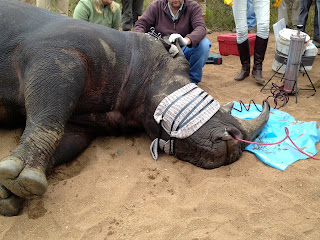This is a baby sable, and we spent a lot of time working on sable. This baby is more tame; the rest of the herds were all completely wild, and we never would have been able to get this close without darting one. By the end of the trip though I had to admit that the sable were really growing on me.
This is more what I thought about when I thought about Africa. This baby zebra was lame, and there ended up being a puncture in the hoof by the coronary band. So we poured some hydrogen peroxide in there and gave the zebra some penicillin. Every animal that we worked on also received a shot with dewormer and vitamins. And for most of the animals we drew blood for DNA testing as well, although we didn't do that on this zebra.
One of the reasons I loved South Africa. It's absolutely gorgeous. This was from the night we went camping.
Another example of why South Africa is so beautiful.
This was the sunrise on the day we went to a private game reserve to work on rhino horn infusions. It is probably one of the only times in my life I've gotten up at 4 in the morning without complaining, and it was definitely worth it. I would do it again in a heartbeat.
The rhino horn infusions involved infusing a combination of an indestructible dye and an organophosphate into the porous rhino horn, which essentially makes the rhino horn worthless on the black market.
Checking the respiration on a rhino. We wanted the respiration rate to be between 8-12.
Checking the pulse on a rhino, which is done by feeling the vessels inside of the ear. The pulse should be around 60.
Each rhino was blindfolded and had cotton placed in its ears to decrease the stress of having so many people around. They also received oxygen, which is what the red tube is for.
On one of our last days we were able to help with giraffe captures, as the giraffe were being moved to another reserve.
Our SA Worldvets group
I think what I would like to do it put up a series of blog posts, where each post covers one or two days of the trip. I learned so much during my time in South Africa, and I don't want to leave anything out just because my fingers are cramping from typing too much. So I'm going to work on getting more up in the next couple of weeks as I have the time.













